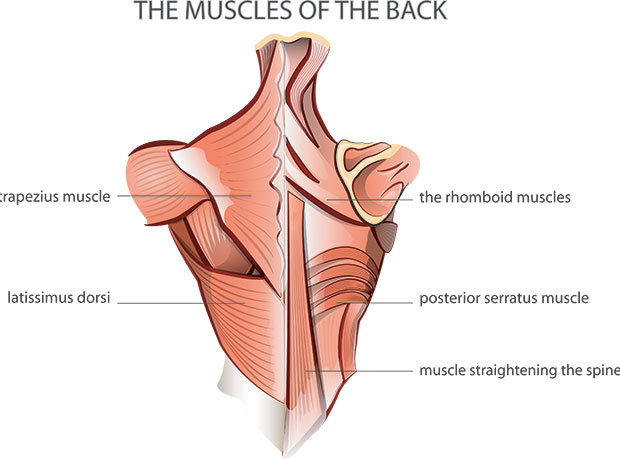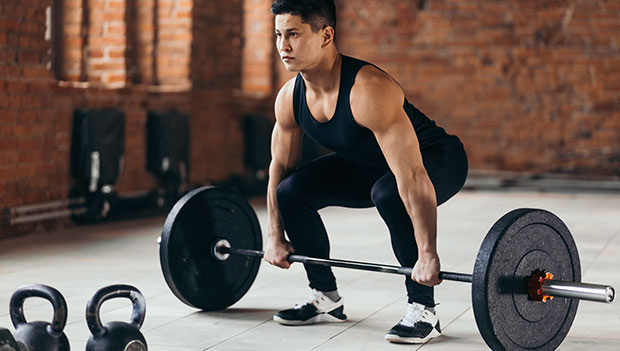
How to Build Muscle | Muscle-Building Nutrition | Muscle-Building Supplements | Hypertrophy Training | Strength Training | Chest Workouts | Back Workouts | Arm Workouts | Shoulder Workouts | Leg Workouts
Your back is an essential part of your body. Aside from the role that your back plays in stability and function, it also plays a key role in both upper-body and lower-body training. Movements such as the deadlift, squat, and overhead press may target more than one area, but your back is key to how well you perform them. No fit body is complete without a strong foundation, and that includes building a bigger and stronger back.
In this back-building guide, we'll show you how to do just that. We'll briefly cover all the major muscle groups that make up the back, how you can train them, and put together a great workout that will help you improve the way your back looks and performs. We'll also share how you can train your back with success while using a variety of training equipment.
Benefits of Back Workouts
Having a strong back will allow you to improve your pulling ability in all directions. Whether it's pulling yourself up, pulling something down, or pulling something toward your body, training your back will help tremendously. From a physique standpoint, you can improve your posture, the way you move, and even fit your clothes better by having a well-developed back. A wider back will make your waist appear smaller, and a strong lower back will help support your core training, as well.
Back Anatomy
There are five major muscle groups to focus on when you're training your back. They are the lats, rhomboids, teres major and minor, the trapezius, and the spinal erectors in your lower back.

Lats
The lats are on the outside of your upper back, and they play some role in every major pulling activity. You can do pull-ups, pick something up off the floor, or pull something toward you, such as a rope, and you'll be working your lats.
Rhomboids
The rhomboids play a big role in the movement of the upper arms, and they provide stability for the shoulder girdle and the scapula. Sit or stand tall and pull your arms in toward your body. You should feel your shoulder blades come in together. You just worked your rhomboids.
Teres Major and Minor
The teres major is recruited when you create shoulder movement. They are above the lats, but they're also known as the "lats' little helpers." The teres minor actually helps provide stability for the ball and socket joint in the shoulder. It also helps laterally and externally rotate the arm.
Trapezius
Many lifters and athletes associate the trapezius, or traps, with the shoulders because they stick up between the shoulder and neck. However, they actually run down the upper back along the spinal cord and are involved when you pull something up from a lower position. Think of a deadlift or shrug motion and you'll know the traps are in action.
Spinal Erectors
The spinal erectors lie on each side of the spinal column and they help with lower back function. Many issues that bother people with lower back problems can be traced to having weak spinal erectors. They help to straighten the back from a bent-over position, and they also assist in side-to-side rotation.
Best Back Exercises
Basic movements are best when it comes to improving the size and strength of your back. Just because it's simple doesn't mean it's easy, though. Many of the best back exercises are compound lifts. Master these movements first, and everything else you can do in the gym for your back will be a lot less challenging.
Pull-up or Chin-up
You will need a pull-up bar or a bar with multiple grips to perform this exercise. Grab the handles and allow yourself to hang. Bend your elbows and pull yourself up until your eyes clear the bar and you can see over. Slowly lower yourself to the starting position and repeat.
An overhand grip works the lats, rhomboids, teres major, and rear delts. A neutral grip will focus more on the lats and incorporate the biceps and forearms. If you use a reverse grip, your biceps will be even more involved. If you're not strong enough to pull your body weight, you can attach a resistance band to the top of the handle, and place your foot in the loop at the bottom. The band will serve as an assistant to get you started on the ascent.
Bent-Over Barbell Row
Stand in a shoulder-width stance with a barbell in your hands with your arms down in front of your thighs. Use either an overhand or underhand grip, but don't use a mixed grip. Bend over at the hips while keeping your back as straight as possible. The barbell should be moving toward the floor. Once your upper body is at a 45-degree position or closer to the floor, pull the bar up until it touches your belly button. Your elbows should go back as far as you can pull them, and your shoulder blades should come together. Slowly lower the bar until it's back to the starting position and repeat. Once you finish your set, lower the bar to the floor.
You can wear a weight belt to support your lower back and lifting straps to support your grip if you feel they are necessary.
Deadlift

Many lifters think of the deadlift as a lower-body exercise, but your back is still very much involved throughout the exercise, and it's most active when you finish the lock-out position.
Stand behind a barbell with a shoulder-width stance. Bend your knees and lower yourself down to grab the bar in a grip that is outside of your legs. Raise your hips up but keep your knees somewhat bent. Keep your back as straight as possible and keep your neck neutral. Pull on the bar and start standing up. Your knees should straighten first. Once the bar clears your knees, pull your hips forward so the bar continues to pull upward until you're standing straight and tall with the weight at arms' length in front of your thighs. Slowly reverse the pattern and return to the starting position. Repeat for the desired number of reps.
Single-Arm Dumbbell Row
This is the premier dumbbell exercise that can help you focus on one side at a time. Begin standing next to a bench or object that you can lean on, with a dumbbell on the floor in front of you. Place your right foot behind you and place your left hand on the bench or object. Grab the dumbbell with your right hand. Your upper body should be parallel with the floor or close to it. Drive your right elbow back as far as you can and lift the dumbbell up and back toward your hip. Squeeze your upper back muscles. Slowly lower the dumbbell back to the starting position and repeat.
After you finish the desired reps on the right side, change your position so you can work your left side. Your left foot should be back and your right hand should be holding on to the bench or object for support. Perform the same motion with the left side for the same number of reps.
Shrug
The shrug can be performed with dumbbells or a barbell. If you hold the barbell, do so with a shoulder-width grip and your arms in front of you. If you use dumbbells, hold one in each hand at your sides. Lift your shoulders straight up as if you're trying to touch them to your ears. Pause and hold the contraction for a second or two. Slowly lower your shoulders back to the starting position, then repeat.
Back Workout with Machines
If you train in a gym or health club, there are machines that can help you train your back thoroughly. Machines are often considered safer than free weights because of the fixed path of travel as well as the ability to isolate the muscles. Exercises such as the seated row, lat pull-down, and others can serve you well if you train in a place that has those machines or if you have a machine that allows you to perform them at home.
Free weights require more stability, but they are tremendous assets in helping you build size and power. The five exercises that we described above can help provide a complete and challenging back workout, as well.
Below are two workouts that you can try for yourself. One is a blend of free weights and machine work, while the other is an all-free-weight session. Regardless of which one you choose, rest for 60 seconds between sets.
Workout 1: Machines and Free Weights
- Pull-up or chin-up: 3 sets of 8-12 reps
- Seated row: 3 sets of 8-12 reps
- Lat pull-down: 3 sets of 8-12 reps
- Dumbbell shrug: 3 sets of 8-12 reps
Note: Rest for 60 seconds between sets.
Workout 2: Free Weights Only
- Deadlift: 3 sets of 8-12 reps
- Pull-up or chin-up: 3 sets of 8-12 reps
- Barbell row: 3 sets of 8-12 reps
- Single-arm dumbbell row: 3 sets of 8-12 reps
- Barbell shrug: 3 sets of 8-12 reps
Note: Rest for 60 seconds between sets.
Back Workout with Bands
If you're limited on what equipment you can use, we also have band exercises that you can do. Having multiple bands with different resistance levels can help you here, but we feel this will also be a great workout to do with limited options or if you're traveling.
Band Row

Wrap a band around a solid object such as a vertical beam or pole. Stand with an end in each hand and walk backward away from the midpoint of the band until you feel balanced tension on both sides. Pull both ends of the band in as far as you can while driving your elbows back. Squeeze and hold this position briefly before releasing the tension. Alternately, wrap the band around the arches of your feet to perform a seated version. Repeat for the desired reps.
Band Pull-down
Wrap the band around a cross beam or pole that is above you. Grab the ends of the band and pull them straight down, driving your elbows down as far as you can. Slowly release the tension by allowing the ends to go back up, then repeat for the desired reps.
Good Morning
Start with a light band for this exercise and master the form with confidence before you try to use a heavier version. Stand in the middle of a continuous band and wrap the other end around the back of your neck and shoulders. Stand with a stance that is a little closer than shoulder width. Hold the middle of the band with your hands. Hinge at the hips while keeping your back straight and lower yourself as far down as you safely can. The band should decrease in tension while you do this.
Next, bring your hips forward and slowly return to a standing position. The band will increase in tension while you do this. The glutes will be working as well, but this is a great band exercise for the spinal erectors.
Band Shrug
Stand in the middle of a band with an end in each hand. The band should have some tension on it while you're standing. Keep your hands at your sides. Perform a shrugging motion as you would if you held dumbbells. The band will add tension as you shrug and it will lose tension as you lower your hands.
The following workout can be done in circuits or as stand-alone exercises. You should be able to finish this workout in around 20 minutes.
- Band row: 3 sets of 8-12 reps
- Band pull-down: 3 sets of 8-12 reps
- Good morning: 3 sets of 8-12 reps
- Band shrug: 3 sets of 8-12 reps
Regardless of which workouts you use, if you train your back every 5-7 days, you should notice improvements in size and strength within six to eight weeks. After that, change the order of exercises so you can keep the improvements coming.
How to Build Muscle | Muscle-Building Nutrition | Muscle-Building Supplements | Hypertrophy Training | Strength Training | Chest Workouts | Back Workouts | Arm Workouts | Shoulder Workouts | Leg Workouts


